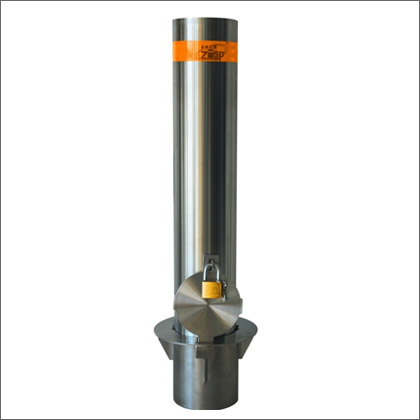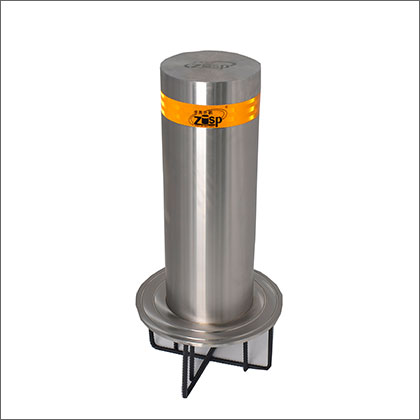Bollards play a crucial role in enhancing safety, traffic management, and the overall organization of parking lots. These sturdy, vertical posts are installed in various locations to prevent vehicle collisions, guide traffic, and protect pedestrians. If you’re managing or designing a parking lot, understanding the different types of bollards and their functions is essential. This guide will walk you through the key considerations when selecting and installing bollards for parking lots.
1. Understanding the Purpose of Bollards in Parking Lots
The primary purpose of bollards in parking lots is to provide safety and control. They serve multiple functions, including:
Traffic control: Bollards help to direct vehicles, delineating driving lanes and pedestrian areas, ensuring smooth traffic flow.
Pedestrian protection: Strategically placed bollards prevent vehicles from entering walkways or colliding with structures like storefronts, keeping pedestrians safe.
Asset protection: Bollards can protect valuable infrastructure like signs, parking meters, and electrical boxes from vehicle damage.
Security: Bollards act as a barrier against unauthorized vehicle access, enhancing the security of restricted areas within a parking lot.
By understanding the purpose of bollards, you can effectively plan their placement to enhance safety and control in your parking lot.
2. Types of Bollards for Parking Lots
There are various types of bollards available, each suited for different needs. Selecting the right type of bollard depends on the level of security required, the area of installation, and the aesthetic of the parking lot. Here are some common types:
Fixed bollards: These bollards are permanently installed and are ideal for areas that require constant protection, such as near building entrances or along pedestrian walkways.
Removable bollards: Removable bollards can be temporarily taken out and are useful in areas where vehicle access needs to be restricted at certain times.
Retractable bollards: These bollards can be manually or automatically lowered into the ground, allowing flexibility for areas that occasionally require vehicle access.
Decorative bollards: In addition to providing safety and security, decorative bollards are designed to enhance the aesthetic appeal of the parking lot. They often feature stylish designs or finishes that complement the surrounding architecture.
High-impact bollards: Built to withstand significant force, these bollards are ideal for areas where vehicle collisions pose a high risk, such as near storefronts or building perimeters.
Choosing the right type of bollard ensures that the parking lot meets both functional and aesthetic requirements.
3. Materials Used for Bollards
Bollards come in a variety of materials, each offering different levels of durability, appearance, and cost. The most common materials include:
Steel bollards: Steel bollards are highly durable and can withstand high impacts, making them ideal for security purposes. They are often filled with concrete for added strength.
Concrete bollards: Concrete bollards are heavy-duty and suitable for areas requiring maximum protection. They are commonly used in high-traffic areas or near valuable infrastructure.
Plastic bollards: Plastic or polyethylene bollards are lightweight and flexible. While they are not designed for high-impact situations, they are useful for guiding traffic or marking pedestrian areas.
Aluminum bollards: Aluminum bollards offer a balance of durability and lightweight design. They are rust-resistant and can be used in a variety of settings where lower-impact protection is needed.
The material you choose will depend on the level of protection required and the overall budget for your parking lot project.
4. Proper Bollard Placement for Maximum Effectiveness
Proper placement of bollards is essential to ensure they serve their intended purpose. Here are some key placement considerations:
Entrance and exit points: Install bollards at the entrance and exit points of the parking lot to control traffic flow and prevent unauthorized access.
Pedestrian areas: Place bollards along walkways and near building entrances to protect pedestrians from vehicles and to prevent cars from mounting curbs.
Drive-through lanes: In areas with drive-throughs or high-traffic zones, bollards can help guide vehicles and prevent them from colliding with infrastructure or other vehicles.
Perimeters: Install bollards along the perimeter of the parking lot or around high-value areas to prevent vehicle encroachment and accidental damage.
By strategically placing bollards, you can improve safety and traffic management throughout the parking lot.

5. Maintenance and Care of Bollards
To ensure your bollards remain effective and visually appealing, regular maintenance is required. Here are a few tips:
Regular cleaning: Clean your bollards periodically to remove dirt, debris, and rust. This is especially important for decorative and painted bollards.
Inspect for damage: Regularly inspect bollards for cracks, dents, or other signs of damage. Replace or repair damaged bollards promptly to ensure safety.
Repaint as needed: If your bollards are painted, consider repainting them periodically to maintain their appearance and protect them from the elements.
Proper maintenance will ensure that your bollards continue to provide protection and enhance the overall appearance of your parking lot.
Frequently Asked Questions About Bollards for Parking Lots
Q: How tall should bollards be in a parking lot?
A: Standard bollards for parking lots are usually between 3 to 4 feet tall. This height is sufficient to be visible to drivers while not obstructing sightlines for pedestrians and vehicles.
Q: Are bollards necessary in every parking lot?
A: While not all parking lots require bollards, they are essential for high-traffic areas, pedestrian-heavy zones, and places where vehicle control and security are a priority.
Q: Can bollards be customized to match the design of the parking lot?
A: Yes, many bollards can be customized with different colors, finishes, and designs to complement the aesthetics of the parking lot and surrounding architecture.
Q: How do I choose between fixed and removable bollards?
A: Choose fixed bollards for areas that require permanent protection or traffic control, while removable bollards are ideal for areas where occasional vehicle access is needed.
Bollards are an essential element in any well-designed parking lot. By understanding their purpose, types, materials, and proper placement, you can improve the safety, security, and functionality of your parking area.


